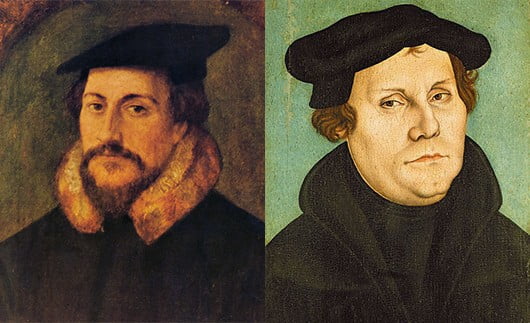Note: This is a sponsored post from the Christian History Institute
—
When it came to marriage, Luther and Calvin were as different as fire and ice.
Luther, perhaps with a few beers under his belt, playfully addressed letters to: “my heartily beloved, gracious housewife … Katherine, Lady Luther, Lady Doctor, Lady of the Pigmarket, and whatever else she may be.” Another time he declares: “I would not trade my Katie for [all of] France or Venice.” … because God gave her to me [and] … me to her.”
Calvin on the other hand (perhaps he should have imbibed a bit more often), bloviated: “I am not one of those insane lovers who [is] … smitten with the fine figure of a woman.”
Although governed by different temperaments, both men married and in their own ways loved their wives. Luther was “crazy” about Katie and could not stop talking about her. Reminiscing over dinner (and more good German beer) some fourteen years after his marriage, Luther regaled his wide-eyed students with the story of his initial encounter with Katie. He was not attracted to Katie at first because he thought she was prideful. He was more interested in Ave von Schönfeld, another of the runaway nuns.
But Luther added that God blessed him with the “happiest marriage.” At times he could not contain his passion: “Katie, you have married an honest man who loves you; you are an empress.” After the birth of his son Paul, Luther declared: “I am rich. My God has given me a nun and three little children.”
The origins of Calvin’s marriage strike a different chord. Having been expelled from Geneva, he found refuge in Strasbourg, and a mentor in Martin Bucer, who pressed the young Calvin to consider a wife. With Calvin’s permission, Bucer established a kind of “search committee” to find him a suitable mate.
At the outset, Calvin gave strict instructions:
Remember, what I expect from one who is to be my companion for life. . . . The only kind of beauty which can win my soul, is a woman who is gentle, pure, modest, economical, patient, and who is likely to interest herself about my health.
Over the next few years, three candidates were presented to Calvin. Candidate #1 was wealthy but did not speak French. Calvin was uncomfortable with her wealth because “it could be embarrassing to a poor minister like myself,” so he walked away.
Candidate #2 spoke French but she was about fifteen years older than Calvin. Suddenly a new criterion emerged regarding age, and he decided this was not a good match.
Candidate #3 met all the key qualifications, and Calvin thought she was the one. Wedding plans were in full swing, but the more he got to know her, the less he liked her. As the wedding date approached, John balked. Unable to face her, he deputized his brother Antoine to deliver the bad news.
On the verge of abandoning his search for a wife, Calvin remembered a converted Anabaptist widow in his congregation. His relationship with her blossomed and within two months, John married Idelette de Bure (August 1540). Almost immediately it became clear where Calvin’s priorities lay. He may have appreciated Idelette, but ministry was his first calling. So it was that Calvin spent 32 of the first 45 weeks of his marriage travelling on church business.
Unlike Luther, Calvin was not prone to public displays of affection and only rarely mentions his wife in his correspondence, so it is difficult to know the personal dynamics of their marriage. After giving birth to a son in July 1542 (who did not survive), Idelette never completely regained her health and finally succumbed in March 1549.
In the immediate aftermath of Idelette’s death, Calvin informs Farel that he has restrained his sorrow “so that my duties may not be hindered.” To his friend Viret he wrote (7 April 1549): “Truly mine is no common grief. I have been bereaved of the best companion of my life … she was the faithful helper of my ministry.” Even in his most tender reflections, Idelette’s primary virtue was that she supported his ministry, which happened to be Calvin’s main criteria for a wife.
In sum, Calvin, by his own confession, was no “insane lover.” By contrast, Luther was “crazy” in love with Katie. Luther’s Facebook timeline would be replete with PDA that would make most of us blush; if you were to scan Calvin’s timeline you might not even know his wife’s name.
However, they both loved their wives and found them to be a wonderful gift from the Father. So, whether Facebook’s accounting of your marriage looks like Luther or Calvin does not matter. Good marriages may look very different and should be measured by the love and devotion of the couple not their willingness to publically display their affection. Although, a little PDA never killed anyone.
—
Frank A. James III is the President and Professor of Historical Theology at Biblical Theological Seminary, Hatfield, PA. He is a presenter on This Changed Everything and is the editor or author of nine books including Church History: Pre-Reformation to the Present (Zondervan) and Peter Martyr Vermigli and Predestination (Oxford University Press).
